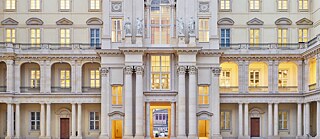The Humboldt Forum “A Sign of Colonial Amnesia”

Schlüterhof courtyard with a view of the Alte Museum and the Lustgarten | Photo (detail): Alexander Schippel © SHF
In December 2020, the Humboldt Forum was opened in the rebuilt Berlin Palace. The museum defines itself as a “place that links differences” and intends to deal intensively with the issues of colonialism in its programme work. The historian and genocide expert Jürgen Zimmerer takes a stand on what is probably Europe’s most controversial museum.
Jürgen Zimmerer highlights three problems with regard to the colonial core of the Humboldt Forum. On the one hand, it is about the tradition of ethnological museums themselves, which have a symbiotic relationship with colonialism. Linked to this is Zimmerer’s second, perhaps most volatile, point of criticism, which raises the question of how to deal with looted colonial art. “It’s mainly about the Benin bronzes. They are world-famous pieces and obviously looted art. 230 of them are to be exhibited in the Humboldt Forum”, says Zimmerer.Looted Art
The Benin bronzes that adorned the palace of the Kingdom of Benin in what is now Nigeria were taken to Europe during the British invasion of 1897 and then sold around the world. Around 1,100 pieces of the stolen goods are in German museums. Nigeria has been demanding the restitution of the works of art for decades. A week before the opening of the Humboldt Forum, the Nigerian ambassador to Germany also asked for the bronzes to be returned.Zimmerer sees the third problematic aspect of the Humboldt Forum in the exhibition building itself. “Basically, it is supposed to represent the rebuilt Hohenzollern Palace. The last ruling monarch of this dynasty was Wilhelm II, in whose name the genocide of the Herero and Nama was committed between 1904 and 1908 in German South West Africa, and that too is a colonial core of the Humboldt Forum.”
Erasing the History of German Violence
Zimmerer interprets the reconstruction of the palace façade and the necessary demolition of the Palace of the Republic, the seat of the East German parliament, as an act of erasing the history of German violence. “The Berlin palace was badly damaged by bombing and was then torn down. This is a symbol of the world war that was begun by Germany. The division of Germany was a consequence of this history of violence. And that is now being erased in the capital of reunified Germany, architecturally restoring the alleged pre-1914 Prussian idyll.”“We can’t tell the narrative of the people of the poets and thinkers without that of the judges and executioners; they are causally connected.”
0 0 Comments